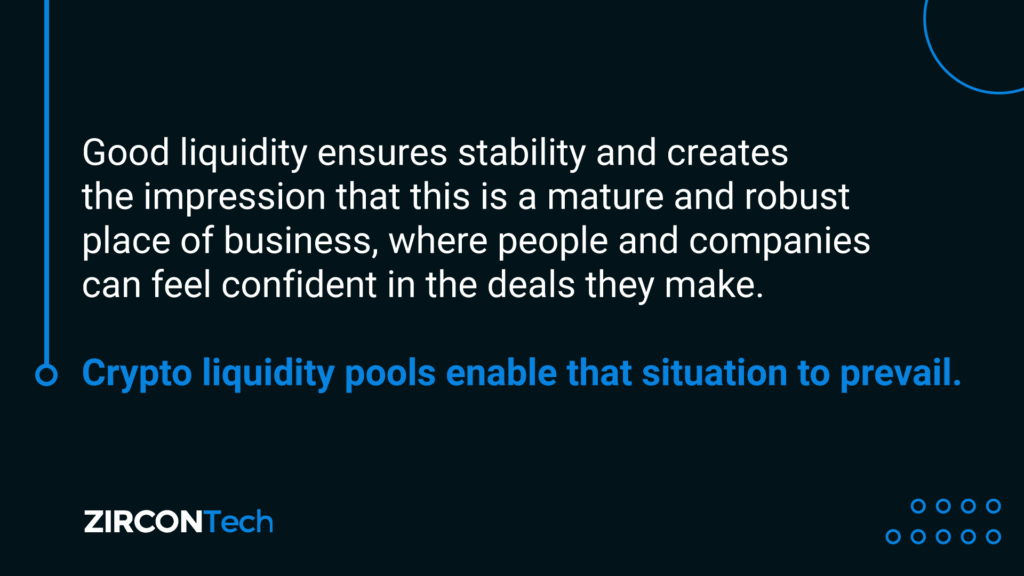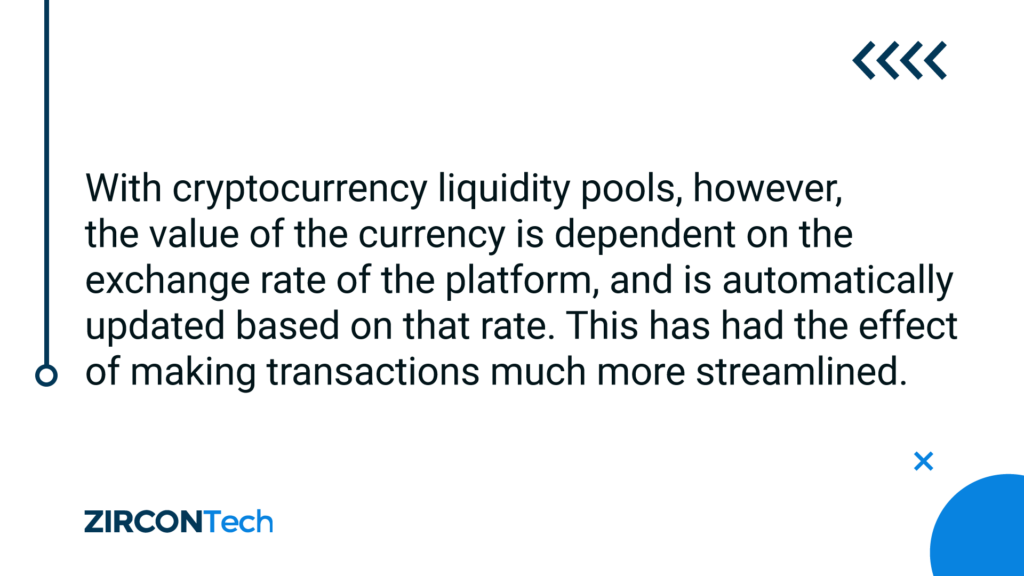Liquidity is a concept that is fundamental to an understanding of, and the successful operation of, any financial system. The simplest definition of liquidity is that it refers to the ease with which any asset can be bought or sold without that action reflecting its market price. Below you’ll see liquidity pools explained in the most simple manner.
The word “liquidity” strongly echoes the process and state it describes. The more liquid a system or market is, the more easily money can flow through and around it – like water in a mountain stream after heavy rain.
As a result, liquidity is essential to the smooth running of any cryptocurrency processes. Which is why the subject of crypto liquidity pools is such an important one to understand for any individual or business that wishes to function successfully in the crypto space.
In this blog, you will find the concept explained in detail. We’ll examine what cryptocurrency liquidity pools are and how they work. We’ll also analyze the game-changing contributions of automated market makers, also known as AMMs. We’ll discuss the concept of the DeFi liquidity pool, and also take a look into the impact that liquidity has on certain areas of the crypto sector.
What are Liquidity Pools?
So let’s begin by making sure we have the concept of liquidity pools explained. To put it simply, cryptocurrency liquidity pools are collections of crypto assets. They are – as the name suggests – a storage place for pools of tokens stored that are locked into a smart contract.
Liquidity pools are used to ensure that trade can take place between the assets on a Decentralized Exchange (DEX). In this way, they illustrate the importance of liquidity in a market place in exactly the same way as a traditional stock exchange does. By ensuring good liquidity within a DEX, the tokens’ owners ensure that the problems caused by bad liquidity do not occur and lead to serious issues for the marketplace.

Good liquidity ensures stability and creates the impression that this is a mature and robust place of business, where people and companies can feel confident in the deals they make. Crypto liquidity pools enable that situation to prevail.
As a result, it is extremely important that crypto liquidity pools are well maintained, in order to keep the levels of trust high. Any investment fund manager that wants to build and operate a liquidity pool will need a license. Similarly, if the pool is ever sold on, an investment fund license will be required to administer the trade.
How do Liquidity Pools Work?
The first thing to understand when you want liquidity pools explained is the crucial role of automated market makers in the way such pools function. The presence of an AMM is one of the essential differences between crypto liquidity pools and traditional stock exchanges.
Instead of the old-style marketplace, which is composed of buyers and sellers, crypto liquidity pools are effectively run by AMMs, which operate in the trading of digital assets in a way that is automatic – as the name suggests – but also permissionless.
In the days before AMMs, there were particular challenges associated with liquidity for DEXs on Ethereum. At a point when there were few buyers and sellers, it was not easy to find enough people willing to trade regularly, and thus keep the liquidity of the market high.
AMMs changed the game by setting up liquidity pools, and by incentivizing individuals and organizations who delivered the liquidity by granting them assets. All this was carried out automatically, without the need for third-party human intervention.
And, as any trader of stocks and shares knows, the more assets there are in a pool, the greater degree of liquidity it displays, and as a result trading on exchanges becomes easier – this effect duly arrived to ease the issues associated with DEXs on Ethereum.
Let’s look at the mechanics of crypto liquidity pools. When two or more tokens or cryptocurrencies are present, it is possible to create a liquidity pool, the creator of which sets the initial price of the assets involved. This should match the price on the global crypto market.
As the pool grows thanks to the contributions of further providers, the tokens in it need to be in line with that market price. This is adjusted by the pricing algorithm that drives the AMMs, which ensures the pool is always liquid.
The pricing of a pool is determined by the ratio of the tokens in it. So if you have an ETH/DAI pool, and someone buys ETH from it, the ratio of DAI increases and its price falls, while the price of ETH rises. The most established liquidity pools can hold investments of about $1million, which makes them resistant to major sudden changes in price.
Advantages of crypto liquidity pools
As we have seen already, there are several ways in which cryptocurrency liquidity pools bring benefits to exchanges, as well as the people and organizations involved in their operation.
The principal advantage, however, is that trading in crypto liquidity pools is not dependent on you finding another party that values crypto in the same way as you. There is no escaping the fact that all too many traders in cryptocurrency have unrealistic expectations, and attempt to set high prices for sales and low ones for acquisitions.

With cryptocurrency liquidity pools, however, the value of the currency is dependent on the exchange rate of the platform, and is automatically updated based on that rate. This has had the effect of making transactions much more streamlined.
Nevertheless, there are some risks associated with taking the plunge into liquidity pools. Never forget that, once you contribute funds to any such pool, ownership is transferred to the pool. There have been cases when a pool’s creator has changed the pool’s regulation to prevent access to the pool, raising the prospect that you could lose your funds.
How is DeFi related to them?
The decentralized finance (DeFi) ecosystem has grown with extraordinary speed since the early days of cryptocurrency. At the end of 2019, there were fewer than 100,000 users of DeFi; by the middle of 2022, the number of unique addresses that had traded a DeFi asset had grown to 4.85 million.

The advantages of DeFi revolve around the fact that it has none of the traditional infrastructure that has always regulated financial systems around the world. It operates in a peer-to-peer fashion, rather than through traditional centralized processes.
This makes crypto liquidity pools a seriously compelling asset for users of DeFi. A DeFi liquidity pool will be characterized by the speed and convenience of its operations.
Liquidity pools are now the heartbeat of many decentralized exchanges. With a centralized exchange, orders are matched through an order book. When it comes to DeFi trading, however, trades are carried out on the blockchain, without a central party having to hold the funds. Where liquidity pools and AMMs have empowered great strides forward is that you no longer need to match your buy with a sell, or vice-versa; you are trading solely against the liquidity in the pool.
Ultimately, cryptocurrency liquidity pools are one of the mechanisms that ensures the success and ongoing appeal of decentralized finance.
Ways to benefit from crypto liquidity pools

So how can investors in the crypto space, people and organizations involved in the DeFi sphere, generate significant benefits from the use of cryptocurrency liquidity pools? There are several outstanding examples, including the following:
Yield farming and liquidity mining
Some protocols now offer tempting incentives for users to contribute to the liquidity of their pools by providing more liquidity provider (LP) tokens. These tokens can be valuable assets in their own right. This is the case when the provider is offered the maximum amount of tokens in exchange for participating in the incentivized pools. Focusing on this type of investment is known as liquidity mining – or yield farming.
There are automated yield-generating platforms – Yearn is a good example – to which users can add their funds via pools that are used to generate such a yield. If you make such a deposit, you receive tokens according to an algorithm. To express it more simply, the process of yield farming is similar to placing your money into an old-fashioned savings account. Over time, you will earn interest on that investment; with yield farming, the benefits accrue in the form of tokenized rewards.
On-chain insurance
Smart contract risk insurance is a hot topic in the cryptocurrency world. Many of the applications in the DeFi sector that focus on this area are supported by crypto liquidity pools.
Governance
People who buy tokens in a particular DeFi liquidity pool, and pay for the trading fees, will in return have an input into the way that liquidity pool is managed. They will be able to vote on issues such as the level of fees charged.
Tranching
Some users of crypto liquidity pools employ this technique, which is also used in traditional financial markets. Tranching means dividing financial products according to the level of risk and return – and liquidity providers can choose their own bespoke risk-and-return profiles.
Minting
Liquidity pools can also be used to support the process of minting synthetic assets on the blockchain. It is possible to create a synthetic token by investing some collateral in a liquidity pool, then connecting it to a trusted oracle.
As the world of decentralized finance continues to evolve, there will no doubt be other compelling use cases for cryptocurrency liquidity pools. This is a technology that has already made a memorable impact on the cryptocurrency space.

The introduction of widespread liquidity has made trading in crypto assets far more streamlined, speedy and user-friendly than it was previously. It has also led to a far greater degree of stability and robustness in cryptocurrency markets.
Given the immense drive for innovation and thirst for a competitive edge that exists within the crypto space, there can be no doubt that further progress in the field of liquidity pools is on the near horizon. As that pace of innovation continues, a partnership with an expert in the field is highly desirable.
Speak to ZirconTech for all your blockchain requirements
ZirconTech brings an immense wealth of experience and knowledge to the sphere of blockchain and its most intriguing and influential elements – such as liquidity pools.

We have forged partnerships around the world with organizations looking to operate at the very cutting edge of technology. As a result, we have built a reputation as a pioneer blockchain development company, with an ability to deliver the transformation that makes a real commercial difference.
If you want to talk about how a partnership with ZirconTech can bring genuine benefits to your business, including visionary insight on all aspects of cryptocurrency and the blockchain, get in touch with us today.